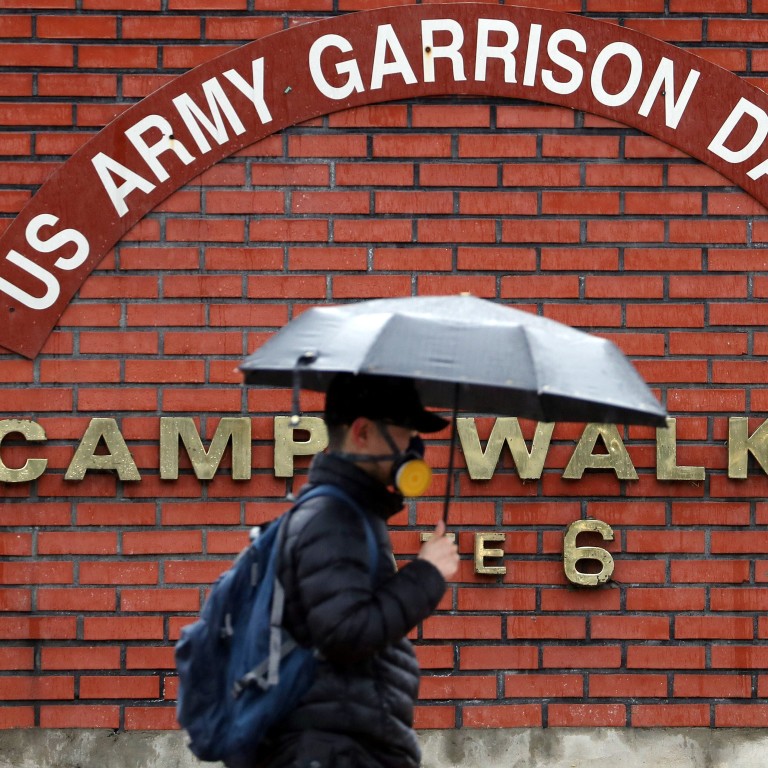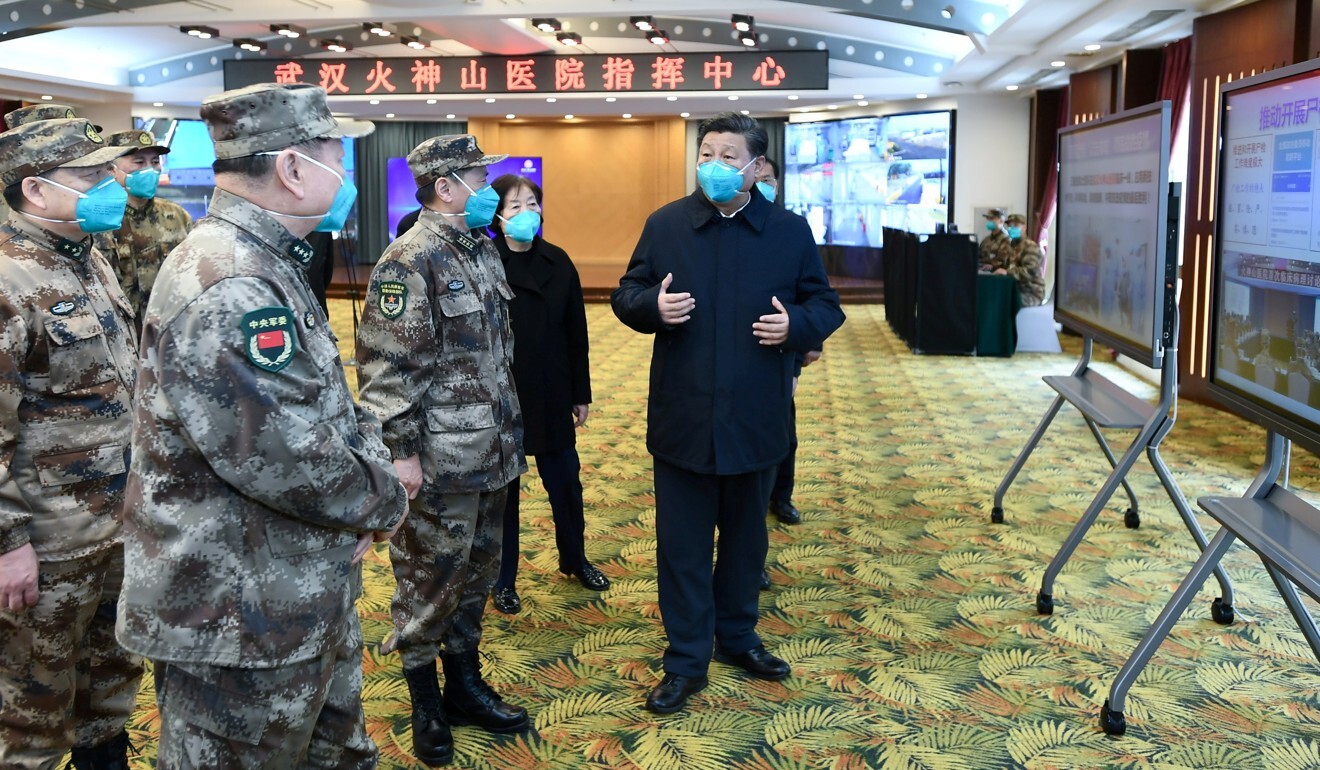
Pentagon and PLA size up their battle readiness in the war on coronavirus
- Though the two militaries operate under vastly divergent systems and expectations, the crisis has allowed each to assess the other under real-world conditions
- While Chinese forces usually respond first when domestic authorities are overwhelmed, the US military historically responds last
In January, Chinese provincial and central leaders failed to act over several crucial weeks as the coronavirus spread throughout the city of Wuhan and eventually worldwide. On February 10, President Xi Jinping called for a “people’s war”, including a central role for the People’s Liberation Army, that eventually helped bring the virus under control.
Seven thousand miles away, US President Donald Trump similarly played down the threat throughout February, squandering critical weeks. Finally, in mid-March with deaths mounting and states pleading for help, he launched an uneven “all of society” response that included a somewhat hesitant Pentagon in a supportive role it wasn’t designed for.
Even as societies and economies are tested worldwide, the coronavirus is challenging the world’s militaries, which are being called on to assist overwhelmed civilian authorities.
The PLA and the US military are very different forces, operating under vastly divergent systems and expectations. But the crisis has afforded an opportunity for the two increasingly adversarial forces to assess their own and each other’s responses under real-world conditions against a pernicious new enemy.
“The coronavirus outbreak is a great battle and a major test for the whole armed forces,” Xi wrote in mid-April, commending the PLA. “They have displayed the dauntless spirit of the Chinese military.”
“We've got to take a hard look at how we as a military, we as the Department of Defence, conduct operations in the future … so that we can continue to be effective in a post-Covid world,” the US Joint Chiefs of Staff chairman, General Mark Milley, said the same week at a virtual press conference.
The PLA has assumed a more central role than its US counterpart in its nation’s crisis, one that has played to its strength as a “people’s military” with extensive domestic experience. This, say analysts, has made it easier to deliver people and equipment to the Wuhan hotspot. As an expanding regional power, it also has fewer competing missions to juggle.
US sailor from aircraft carrier Theodore Roosevelt dies of coronavirus
The crisis has also provided a key test of PLA reforms enacted in 2016 that created a centralised, tech-driven logistics arm known as the Joint Logistics Support Force, coincidentally based in Wuhan. A military maxim is that logistics win wars, and the restructuring was aimed at reducing internal competition for resources in order to better project Chinese power overseas.
“There’s a lot of evidence they coordinated pretty well. The military was able to get lots of doctors from bases to ground,” said Joel Wuthnow, a Chinese military research expert at the National Defence University. “Reforms seem to have paid some dividends.”
But experts add that PLA secrecy makes it difficult to fully assess its performance. In recent weeks, even as the virus infected French and US aircraft carriers and ravaged bases globally, the world’s largest military with 2 million active soldiers boasted a perfect record.
“The PLA claims it’s had zero casualties from the virus. That’s laughable,” said Wuthnow, author of the book Chinese Diplomacy and the UN Security Council: Beyond the Veto. “It’s hard to judge failure. We’re not going to see any of that.”
In contrast, the Pentagon has seen early confusion over its use of naval hospital ships and response to shipboard infections play out in real time.
Its less robust response compared with the PLA also reflects a very different Western military tradition focused almost exclusively overseas, answerable to the nation not one political party, wary of getting bogged down in ways that might undercut its readiness against foreign military threats.
And with some 67,000 US Air Force and 155,000 US Army personnel stationed overseas in multiple conflict zones, it is juggling many more moving parts than the Chinese military.
While the PLA has historically responded first when domestic authorities are overwhelmed, the US military has generally responded last, after state governments, the Federal Emergency Management Agency (FEMA), the business community and state-directed National Guard units.
“The US is an expeditionary force. We don’t fight at home,” said Rebecca Hersman, a programme director at the Centre for Strategic and International Studies and a former Defence Department expert on biological, chemical and nuclear threats. “That’s the challenge for the US military in situations like this.”
China sends fresh military medical crews to coronavirus-hit Wuhan
The deployment of two US Navy hospital ships – Comfort to New York and Mercy to Los Angeles, which are configured for combat trauma – underscored some of this discomfort as commanders initially resisted allowing Covid-19 patients aboard, leading to early criticism of the military’s – and Trump’s as commander in chief – underwhelming response.
Questions over what role the US military should take became more pointed when outbreaks aboard three US aircraft carriers in the Pacific coincided with provocative actions by Russia, Iran and North Korea within a 24-hour period even as China flexed its muscles in the South China Sea.
“Bad guys are not taking any time off,” Lieutenant General Bradford Shwedo said during a mid-April press briefing. The US military will “defend this country from anyone who would mistakenly try to exploit this current situation”.
The pandemic’s timing also favoured the PLA. Large-scale military exercises in China generally run from April to November so most forces were housed at bases around China, close to Wuhan and able to take preventive measures to stem infection in the ranks.

The US, which does not have much of a training hiatus, was forced to cancel major European and Korean exercises, halt travel, suspend training exercises and delay boot camp but still suffered thousands of infections.
The US military, already wary of becoming too entangled domestically, also has struggled to find its place amid a national response characterised by indecision, disjointed leadership and political sniping. “Just stay calm,” Trump said of the pandemic as late as March 10. “It will go away.”
Trump waited until March 22, when there were already 32,000 coronavirus cases and 400 deaths, before designating New York and California disaster areas, freeing up funds for stretched National Guard units. Further confusing the command structure was Trump’s claims of “total power” over state governors even as he insisted they solve their own problems. “We’re not a shipping clerk,” he snapped at one point.
New York state deploys National Guard to create virus containment zone
“China and the PLA attacked it as a people’s war,” said Dennis Blasko, an independent analyst and former US Army attaché to Beijing and Hong Kong. “We still don’t have a whole of government strategy.”
The more domestically focused Army Corps of Engineers and National Guard were initially deployed to help convert convention centers into makeshift hospitals and unload grocery trucks. But up to one-fifth of National Guard medical staff also works in civilian hospitals, hampering their ability to assist elsewhere.
With desperate states calling for military hardware and expertise, the Pentagon released millions of N95 masks and thousands of ventilators from its strategic reserves, but demurred on contributing many assets or traditional capability beyond the hospital ships.
“I’m not sure how many outside teams have gone into our most hardest-hit areas, I don’t see that going on,” said Blasko. “It’s sort of like ‘you’re on your own, buddy.’”

Also giving military leaders pause is Trump’s history of firing and publicly humiliating senior defence and intelligence officials and second-guessing commanders. Trump initially expressed support for the acting Navy secretary’s decision to fire the commander of the aircraft carrier Theodore Roosevelt after his urgent concerns over shipboard infections leaked.
But as public opinion turned against the acting Navy secretary’s decision, which Trump claimed he had no role in, the president indicated he might reinstate the vessel’s commander. “I like to solve problems,” he said.
While the PLA appeared to pass an early logistical test, analysts say the challenge was relatively limited without an enemy trying to disrupt supply lines, communications systems or databases.
US Navy chief resigns after firing captain who raised coronavirus alarm
Also unclear from the crisis is the PLA’s ability to cooperate across its geographical and functional units.
“This is a problem that exists everywhere, but it’s a particular problem in China because of how the system was set up,” said Helena Legarda, a military analyst with Germany’s Mercator Institute for China Studies. “There’s still a fair bit of duplication.”
Adding to the PLA’s challenge is tension between a traditional, highly centralised command structure under the Chinese Communist Party and pressure driven by modern technology and military doctrine to bolster autonomy at the unit level.
Most Chinese troops spend little time outside their home province. Even as peacekeepers in Africa, they tend to be consigned to barracks, which doesn’t necessarily encourage initiative.
As the crisis intensified, Beijing sent a top discipline inspection official to Wuhan, apparently fearful that PLA forces might resist being exposed to the disease.
“We don’t know about the morale in the field itself. These guys probably don't want to be going out there and doing this and why would they?” said Wuthnow. “You need big brother to watch over their shoulders every step of the way.”
The US military, meanwhile, has faced several tests of its own from this global health crisis, analysts said. Despite having carried out several pandemic exercises and a 2014 Ebola mission in Africa, it was not prepared for an adversary that so widely infected its own ranks. “How can the military protect America when it can’t protect itself?” The Atlantic magazine asked.
It underestimated its vulnerability, reacted slowly and failed to protect sailors at sea where social distancing is difficult, analysts say.
How will world’s most powerful military fight coronavirus threat?
“In the same way the federal government did not take this risk seriously enough in January and February, it seems to have occurred across the military as well,” said Hersman. “Then you add in an environment where it’s incredibly difficult to deliver bad news. The Theodore Roosevelt had bad news to deliver, but it was not able to engage in proper procedures to address it.”
The crisis also has challenged the Defence Department’s – and likely the PLA’s – ability to work remotely. US contractors had trouble accessing servers even as a government oversight report found that Pentagon staff were poorly trained in following the safe online practices they demand of suppliers.
Even as the US military braces for more pandemics and the impact of global warming, analysts say they don’t expect it to change its relatively hands-off approach to domestic missions.
“They’re really not pushing the envelope,” Hersman said. “Carrying out some sort of quarantine enforcement, that would be a bad day. And hopefully we never even have to think about that. I expect in China, that’s commonplace.”

